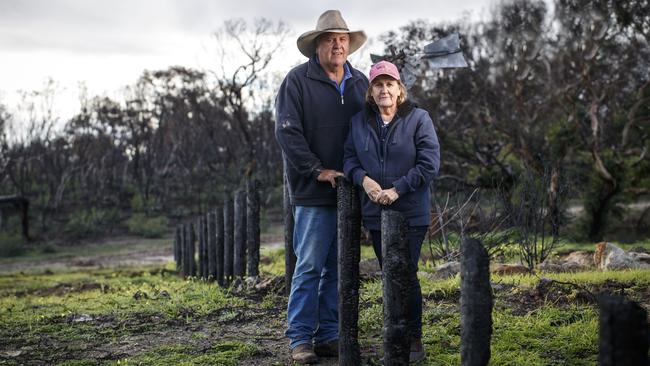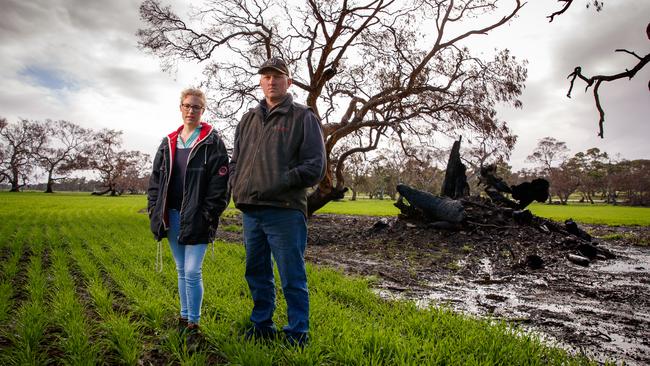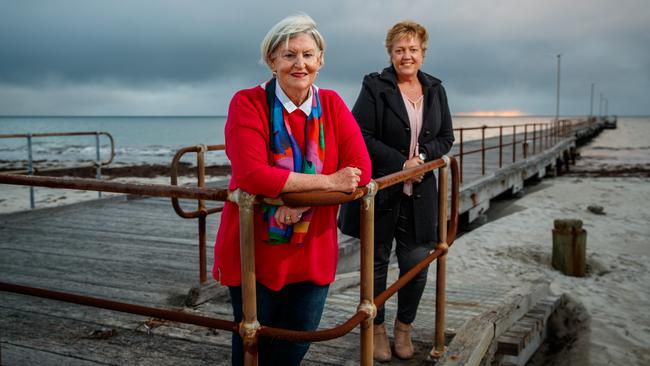The SA town fighting back from forgotten inferno
All eyes were on Kangaroo Island and Cudlee Creek when catastrophic fires raged in SA in the summer. But another community faced its own disaster.

SA News
Don't miss out on the headlines from SA News. Followed categories will be added to My News.
- Mt Gambier private prison ‘barely a jail,’ killer says
- Are you getting the most from your Advertiser subscription?
It was branded the forgotten fire of South Australia’s devastating summer – but the hardy folk of Keilira, in the state’s South-East, don’t want a bar of that.
Instead, they are resolutely getting on with life in the aftermath of the rapid blaze, sparked by dry lightning on December 30 last year, which scorched more than 25,000ha.
The grass fire burnt through 2000 hay bales and 400km of fencing on three properties, killing about 3000 sheep and 400 cattle.
It also destroyed Bin Bin Station – the almost 20-year home of Phil and Anthea Clarke. The couple had near misses in 2013 and 2017. In 2019, it was third time unlucky.
“The wind change pushed it east towards us. I headed home and drove through burning roads and got up on the hill and got a UHF message to Anthea to just go,” Mr Clarke, 62, said.
“The fire was over the top of the big gum trees and going mad. It was black as black.
“When I was coming down the road I couldn’t really see in front of me. I was just using the burning trees as a guide. I met (Anthea) on the road and said ‘well there goes the house’.
“We watched it burn down from a couple of kilometres away and that was about five minutes from when I got her on the UHF.”
Mrs Clarke recalled managing to grab only a couple of bags of clothes, computer and the dog before fleeing.
“The bottom of our driveway was just black,” Mrs Clarke, 59, said.
“I didn’t actually see flames because it was just so black and I came across Phil who said he was going to sit down the road and told me to get going.”
More than 2630ha of their 3850ha property was blackened in the fire but, six months later, the Clarkes have reseeded their paddocks and, with the help of BlazeAid, fixed their fences.
Now they are looking to rebuild their house on the same block. “We left the house until last to get the farm up and running again and now we will start organising that,” Mr Clarke said.
“This is home and the house that we’re building has a fire blanket included in the roof and we will set up a steel sprinkler system.”
Mr Clarke, a Country Fire Service volunteer of 20 years, found his scorched 10-year service medal among the ruins of his former home.
However, in some good timing, a cherished clock originally given to his grandfather in 1926 was being repaired in Tanunda when the fire ripped through.
“When the new house is up and we go into it will be a bit different. We had a lot of stuff we don’t have now,” Mrs Clarke said.
“We had a lot of Phil’s grandparents’ furniture and his panda from when he was a baby. It’s those things you can’t replace but we will find stuff to fill the holes.”
The couple said they were grateful for help from neighbours near and far and BlazeAid volunteers who stayed until all their fences were repaired.
“Fire is not a good a thing but it really does lift your faith in humanity. We’ve had people from an hour and a half away offering help,” Mr Clarke said.
Mr Clarke said locals did not need pity nor did they worry about the lack of public attention in comparison to the Cudlee Creek and Kangaroo Island fires.
“Everyone got hit the same. I feel sorry for them as much as I do for everyone around here. Fire is fire and I can’t say that we’ve missed out,” he said.
“You’ve just got to get on with it and we’ve had a lot of help getting on with it. The community has just been unbelievable.”

A little more than 10km down the road, David and Fiona Rasheed had more than three-quarters of their 4650ha property – including 115km of fencing on three blocks – wiped out.
Fortunately, despite the blaze encroaching on the garden, their house remained unscathed.
Mr Rasheed estimated he lost about 900 sheep and 15 cattle but that 4000 to 5000 sheep and 400 to 500 cattle survived.
“In the end we didn't lose as much stock as we could’ve lost. We could’ve lost the whole lot,” Mr Rasheed, 44, said.
“We had a couple of people standing down the front and it was on its way and we knew it was coming and we had five or 10 minutes waiting for it.
“I got dad to get the tractor and start ploughing breaks randomly. When the fire came through the smoke was that bad that dad was nearly driving into the trees.
“I had the sprinklers on but as soon as the power went off the sprinklers stopped working with the pump.”
Mrs Rasheed, who was in Kingston SE as the fire tore through, said the lack of reliable communication infrastructure was problematic.
“We were looking up CFS reports all the time but it’s really hard to get information but there was a group of us on messenger just giving each other updates,” Mrs Rasheed, 37, said.
“That’s what the kids were worrying about the most and they were upset about what might happen to the house but when they knew they house was OK it was a lot easier for all of us.”
The couple said they were thankful for the cooler and wetter conditions since the fire that had prompted regeneration and allowed them to get sheep out into the paddocks before lambing. Mr Rasheed said the support of neighbours and BlazeAid had helped them repair fences to make the property stock proof although he forecast several years’ more work.
“Some of (the locals) had experienced fires through Ash Wednesday and other fire events and they knew what we were going through so they came up to help,” he said.
MORE NEWS
SA could record dozens of new covid cases with days
How Liberal, Labor combined to crush Mr X
Embattled mayor knows his days are numbered
Mrs Rasheed said described the assistance as “absolutely overwhelming”.
“That first month there were just so many offers of help and people rocking up the day of the fire, the next day that whole week coming out to do what they could,” she said.
The couple acknowledged why the Keilira blaze had been dubbed the forgotten fire but were still personally connected to devastation of Kangaroo Island, where Mr Rasheed’s first cousin, Tom Wurst, and his family lost their home.
Kingston District Council mayor Kay Rasheed said the Keilira blaze was the biggest in the region since the Ash Wednesday fires of 1983.
“(The Adelaide Hills and Kangaroo Island fires) were one of the reasons that our fire did get a little bit left behind because it was a major fire for down here,” Ms Rasheed said. “We just get on with it but because the fires on KI and in the Adelaide Hills were so severe and so disastrous you can understand why the focus was on that and people here understood.
“But even so it was a really big fire and it did burn a lot of pasture and a lot of stock was lost.”
She said “real country friendship” and camaraderie had helped the tight-knit community.

Kingston District Council chief executive Nat Traeger said it had to lobby the state and federal governments before receiving $200,000 in bushfire recovery funding.
Ms Traeger said the council had also pledged $50,000 towards the mobile black spot fund for the installation of two phone towers to address mobile phone communication deficiencies.
The council is also delivering mental health and resilience programs and was recently awarded a $30,000 federal grant for a tourism stimulus project it hopes to deliver during the summer.
“We’re going to be developing a tourism artwork in the main street of Kingston, which will be a game-changer,” Ms Traeger said.
“It’s going to be the first augmented reality public artwork in South Australia to recognise the input of the community.
“Certain components of it will come to life so when you’re looking at the artwork with an app … part of it will move and look like it’s coming off the wall.
“Because it’s a tourism focused project they’re hoping at night it looks different than during the day or it changes on the hour.”
Originally published as The SA town fighting back from forgotten inferno


